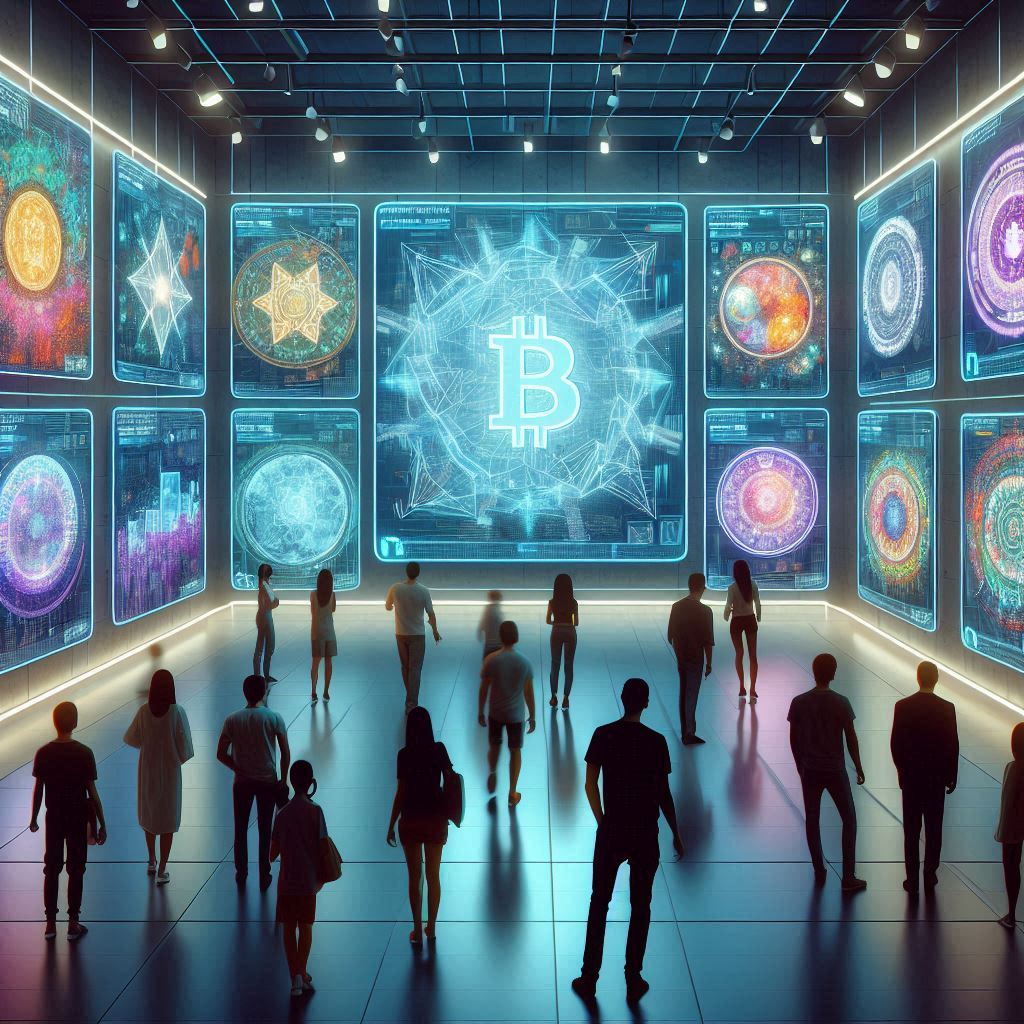Non-Fungible Tokens, or NFTs, are a type of digital asset that represent ownership of unique items or content. Unlike cryptocurrencies like Bitcoin or Ethereum, which are fungible and can be exchanged on a one-to-one basis, NFTs are unique and cannot be exchanged equivalently. This uniqueness makes NFTs ideal for representing ownership of digital art, collectibles, and other unique assets.
NFTs utilize blockchain technology to verify ownership and authenticity. Each NFT is stored on a blockchain, which acts as a decentralized ledger that records every transaction. This ensures that the ownership of the NFT can be traced back to its original creator, providing a level of transparency and security that is crucial for digital assets.
The Evolution of NFTs
The concept of NFTs has been around since the early 2010s, but it wasn’t until recent years that they gained mainstream attention. Early experiments with NFTs included projects like CryptoKitties, a blockchain-based game that allowed users to buy, sell, and breed digital cats. These early projects laid the groundwork for the explosion of interest in NFTs that we see today.
In 2021, NFTs entered the mainstream consciousness when digital artist Beeple sold an NFT for $69 million at a Christie’s auction. This sale marked a turning point, demonstrating the potential value of digital art and the power of NFTs. Since then, the NFT market has grown exponentially, with artists, musicians, and even sports leagues embracing the technology.
NFTs in the Art World
One of the most well-known applications of NFTs is in the art world. Digital artists can create unique pieces of art and sell them as NFTs, allowing them to reach a global audience and monetize their work in new ways. NFTs provide artists with a level of control and ownership that was previously impossible in the digital realm.
By using NFTs, artists can also earn royalties on secondary sales of their work. This means that if a piece of art is resold, the original artist can receive a percentage of the sale price. This has the potential to revolutionize the art market, providing artists with a new revenue stream and ensuring they are fairly compensated for their work.
Beyond Art: Music and Entertainment
NFTs have also made significant inroads in the music and entertainment industries. Musicians can create NFTs that represent ownership of their songs, albums, or even concert tickets. This allows them to sell directly to fans and bypass traditional distribution channels.
In the entertainment industry, NFTs can be used to represent ownership of exclusive content, such as behind-the-scenes footage, limited edition merchandise, or even virtual meet-and-greets with celebrities. This creates new opportunities for fan engagement and monetization, allowing creators to connect with their audience in unique ways.
Virtual Real Estate and Metaverses
Another exciting application of NFTs is in the realm of virtual real estate and metaverses. Virtual worlds, such as Decentraland and The Sandbox, allow users to buy, sell, and develop virtual land using NFTs. These virtual spaces can be used for a variety of purposes, from hosting events and exhibitions to creating interactive experiences.
Owning virtual real estate as an NFT provides a sense of ownership and investment in the digital world. Just like physical real estate, virtual land can appreciate in value over time, providing a potential return on investment. As the metaverse continues to grow, the demand for virtual real estate is likely to increase, making it a valuable asset.
Gaming and In-Game Assets
The gaming industry has also embraced NFTs, with many games incorporating blockchain technology to create unique in-game assets. These assets can range from virtual weapons and armor to rare skins and characters. By using NFTs, gamers can truly own their in-game items and trade them on secondary markets.
This ownership model provides gamers with more control and the ability to monetize their gaming experience. It also opens up new possibilities for game developers, allowing them to create more immersive and interactive experiences. As blockchain technology continues to evolve, we can expect to see even more innovative uses of NFTs in gaming.
NFTs in Fashion and Virtual Wearables
The fashion industry is exploring the potential of NFTs through virtual wearables and digital fashion. Designers can create unique digital clothing and accessories that can be worn by avatars in virtual worlds or displayed in digital galleries. These virtual wearables can be bought, sold, and traded as NFTs, creating a new market for fashion enthusiasts.
Virtual fashion offers several advantages, including sustainability and creativity. Designers are not limited by the constraints of physical materials, allowing them to push the boundaries of creativity. Additionally, virtual fashion reduces the environmental impact of traditional fashion production, making it an eco-friendly alternative.
NFTs in Sports and Collectibles
Sports leagues and athletes are leveraging NFTs to create digital collectibles and memorabilia. Fans can purchase NFTs that represent ownership of highlights, trading cards, or even virtual tickets to games. This provides a new way for fans to engage with their favorite sports and players.
NFTs in sports also offer the potential for fan experiences and exclusive content. For example, an athlete could create an NFT that grants the owner access to a virtual meet-and-greet or a signed piece of merchandise. This creates new revenue streams for athletes and teams while enhancing fan engagement.
NFTs in the Real Estate Industry
While virtual real estate is gaining traction, NFTs are also being explored for use in the physical real estate industry. Property developers and investors can use NFTs to represent ownership of real-world properties. This can simplify the buying and selling process, providing a secure and transparent way to transfer ownership.
Using NFTs in real estate can also open up new possibilities for fractional ownership. Investors can purchase a share of a property as an NFT, allowing them to invest in real estate without the need for significant capital. This democratizes access to real estate investment and provides more opportunities for diversification.
Legal and Regulatory Challenges
As with any emerging technology, NFTs face several legal and regulatory challenges. Issues such as intellectual property rights, taxation, and anti-money laundering regulations need to be addressed to ensure the safe and sustainable growth of the NFT market.
Regulators are starting to take notice of NFTs, and we can expect to see more guidelines and frameworks established in the coming years. This will provide clarity for creators, investors, and consumers, helping to build trust and confidence in the NFT ecosystem.
The Environmental Impact of NFTs
The environmental impact of NFTs has been a topic of debate, particularly due to the energy consumption of blockchain networks like Ethereum. Minting and trading NFTs require significant computational power, leading to concerns about carbon emissions and sustainability.
Efforts are being made to address these concerns through the development of more energy-efficient blockchain technologies. Projects like Ethereum 2.0 aim to reduce the environmental impact by transitioning to a proof-of-stake consensus mechanism. Additionally, some platforms are exploring carbon offset initiatives to mitigate their environmental footprint.
NFTs as Investment Vehicles
NFTs are increasingly being viewed as investment vehicles, with collectors and investors seeking to capitalize on their potential value. Just like traditional art or collectibles, the value of an NFT can appreciate over time, providing a return on investment.
However, investing in NFTs comes with its own set of risks. The market is still relatively new and can be volatile, with prices fluctuating based on trends and demand. It’s important for investors to conduct thorough research and understand the potential risks before diving into the NFT market.
Community and Social Impact
NFTs have the potential to create positive social impact by empowering creators and communities. By providing a new way to monetize digital content, NFTs can help artists, musicians, and creators earn a fair income for their work. This can be particularly beneficial for underrepresented groups and communities.
NFTs also facilitate the creation of decentralized communities, where members can collaborate and share value. These communities can support initiatives such as charity projects, social causes, and grassroots movements, creating a positive impact beyond the digital realm.
The Future of NFTs
The future of NFTs looks promising, with continued innovation and adoption expected across various industries. As blockchain technology evolves, we can expect to see new use cases and applications for NFTs, further expanding their potential.
From virtual worlds and gaming to real estate and fashion, NFTs are poised to transform how we interact with digital and physical assets. The key to their success lies in addressing the challenges and building a sustainable and inclusive ecosystem that benefits creators, investors, and consumers alike.
Conclusion: Embracing the NFT Revolution
The rise of Non-Fungible Tokens (NFTs) is revolutionizing the way we think about ownership, creativity, and value. Beyond art and collectibles, NFTs are making their mark in industries as diverse as music, fashion, real estate, and gaming. By embracing NFTs, we are unlocking new possibilities for innovation, engagement, and economic empowerment.
As the NFT market continues to evolve, it’s essential to navigate the challenges and seize the opportunities presented by this exciting technology. By doing so, we can build a future where NFTs are an integral part of our digital and physical lives, driving progress and creating lasting value.


